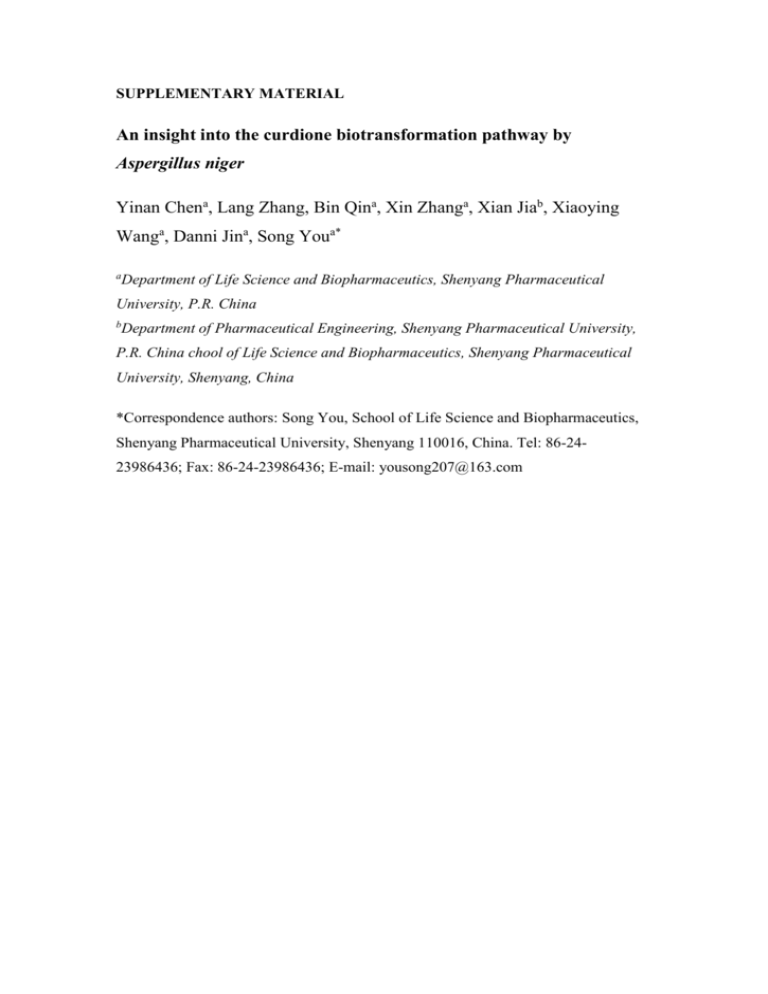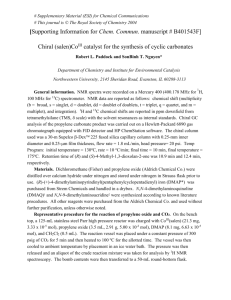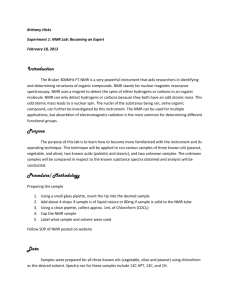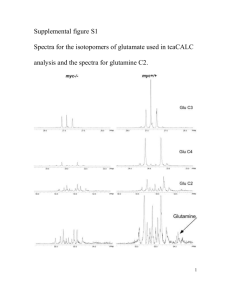GNPL_Supplementary Material_Template_Word_XP_2007
advertisement

SUPPLEMENTARY MATERIAL An insight into the curdione biotransformation pathway by Aspergillus niger Yinan Chena, Lang Zhang, Bin Qina, Xin Zhanga, Xian Jiab, Xiaoying Wanga, Danni Jina, Song Youa* a Department of Life Science and Biopharmaceutics, Shenyang Pharmaceutical University, P.R. China b Department of Pharmaceutical Engineering, Shenyang Pharmaceutical University, P.R. China chool of Life Science and Biopharmaceutics, Shenyang Pharmaceutical University, Shenyang, China *Correspondence authors: Song You, School of Life Science and Biopharmaceutics, Shenyang Pharmaceutical University, Shenyang 110016, China. Tel: 86-2423986436; Fax: 86-24-23986436; E-mail: yousong207@163.com An insight into the curdione biotransformation pathway by Aspergillus niger Curdione (1), a sesquiterpene with a germacrane skeleton from rhizomes of Curcuma wenyujin, has attracted attention due to its important pharmacological properties. Herein, we investigated the chemo-biotransformation of curdione (1) systematically using Aspergillus niger AS 3.739. Regio- and stereoselective hydroxylation of curdione with filamentous fungus A. niger AS 3.739 led to seven metabolites including four new compounds 3α-hydroxycurcumalactone, 2β-hydroxycurcumalactone, (10S)-9,10-dihydroxy-curcumalactone and (10R)9,10-dihydroxy-curcumalactone. Their structures were determined by spectroscopic techniques including two-dimensional NMR and TOFMS. Based upon the analysis of biological and chemical conversions of curdione, a tentative metabolic pathway via chemo-bio cascade reactions is proposed in A. niger system, which provides an insight into the corresponding metabolism of curdione in animal systems. In addition, experiments with selected monooxygenase inhibitors suggest that cytochrome P450 monooxygenase played a crucial role in the hydroxylation of curdione. Keywords: curdione; Aspergillus niger AS 3.739; biotransformation; hydroxylation; cytochrome P450 Identification of novel curdione metabolites 3α-hydroxycurcumalactone (5) White amorphous powder; [α]25D: -56.1 (c 0.85, MeOH); IR (KBr): νmax cm-1 3442, 2964, 1761, 1642; 1H and 13C NMR data, see Tables S1 and S2, respectively; ESITOFMS: m/z [M+Na]+ 275.1622 (calc. for C15H24O3Na, 275.1623). Anal. Calcd. (%) for C15H24O3: C, 71.39; H, 9.59; found: C, 71.58; H, 9.64. Compound 5 was deduced to be C15H24O3 from its ESI-TOFMS data (m/z 275.1622 [M+Na]+, calcd. 275.1623), indicating the introduction of an oxygen atom. Absorption in the IR spectrum showed a hydroxyl stretch at 3442 cm-1. The data from 1 H and 13C NMR and DEPT suggested that the presence of 15 carbons was attributed to four methyl carbons, three methylene carbons, five methine carbons and three quaternary carbons (including an ester carbonyl carbon). The 13C NMR and DEPT data demonstrated that 5 had the same basic skeleton as curcumalactone (4), and the 13 C NMR spectra of 5 indicated the disappearance of methylene carbon signals and the presence of a new methine carbon resonance at δ 74.2. All of these observations suggested that 5 was a hydroxylated metabolite of 4. In the HMBC spectrum, correlations from H-1 (δ 3.03), H-2 (δ 2.13), H-4 (δ 2.36) and H-14 (δ 1.09, d, J = 6.9 Hz) to C-3 (δ 74.2) indicated that the hydroxyl group was linked to C-3. These demonstrating results were corroborated by the correlations of H-3 (δ 3.71) with H-2 (δ 2.13) and H-4 (δ 2.36) in the 1H-1H COSY spectrum. The relative configuration of hydroxyl was proved as α-configuration by the NOE contacts between H-14 (δ 1.09, d, J = 6.9 Hz) and H-3 (δ 3.71) were observed in the selective NOE spectrum (Figure S1). Thus, compound 5 was characterized as 3α-hydroxycurcumalactone. 2β-hydroxycurcumalactone (6) -1 White amorphous powder; [α]25 D : -7.2 (c 0.86, MeOH); IR (KBr): νmax cm 3465, 2958, 2926, 1765; 1H and 13C NMR data, see Tables S1 and S2, respectively; ESITOFMS: m/z [M+Na]+ 275.1617 (calc. for C15H24O3Na, 275.1623). Anal. Calcd. (%) for C15H24O3: C, 71.39; H, 9.59; found: C, 71.48; H, 9.72. The molecular formula of 6 was established as C15H24O3 using ESI-TOFMS (m/z 275.1617 [M+Na]+, calcd. 275.1623). The IR spectrum displayed a strong hydroxyl stretch at 3465cm-1. The spectroscopic features of 6 were essentially analogous to those of compound 5, exhibiting signals lactone ring at δ 93.1 (C-5), δ 24.5 (C-6), δ 46.5 (C-7), δ 178.2 (C-8), a isopropyl side-chain at δ 28.3 (C-12), δ 20.5 (C-13), δ 18.0 (C-14), and an isopropenyl at δ 116.3 (C-9), δ 141.8 (C-10), δ 27.2 (C15). The 13C NMR spectra indicated the appearance of one new oxygen-bearing carbon signal at δ 69.7, suggesting 6 was a hydroxylated product. Compared with 5, the spectrum of 6 showed that C-1 resonated at a lower field and C-4 resonated at a higher field, indicating oxidization had occurred at C-2. In addition, the correlations observed in the HMBC spectrum between δ 69.7 and H-1 (δ 2.59, d, J = 6.3 Hz), H-3 (δ 2.48), H-4 (δ 1.29), H-9 (δ 5.19), suggested that the hydroxylation had taken placed at C-2 (δ 69.7). The coupling constant of H-1 (δ 2.59) and H-2 (δ 4.31) was 6.3 Hz, indicating that the relative configuration of H-1 and H-2 was a cis form. Furthermore, the α-configuration of H-1 suggested a β-configuration for C2-OH. Therefore, 6 was identified as 2β-hydroxycurcumalactone. (10S)-9,10-dihydroxy-curcumalactone (7) Colorless oil; [α]25D: -22.7 (c 0.82, CHCl3); IR (KBr): νmax cm-1 3426, 2963, 2932, 2874, 1708; 1H and 13C NMR data, see Tables S1 and S2, respectively; ESI-TOFMS: m/z [M+Na]+ 293.1722 (calc. for C15H26O4Na, 293.1729). Anal. Calcd. (%) for C15H26O4: C, 66.64; H, 9.69; found: C, 66.46; H, 9.56. Data from ESI-TOFMS (m/z 293.1722 [M+Na]+, calcd. 293.1729) of compound 7 suggested a molecular formula of C15H26O4 . The IR spectrum displayed absorption for hydroxyl function at 3426 cm-1. Based upon the data from DEPT and HSQC experiments, four methyl carbon signals, four methylene carbon signals, four methine carbon signals and three quaternary carbon signals could be assigned. The one characteristic carbonyl group resonated at δ 181.6, one quaternary carbon resonated at δ 94.2, four methyl group signal at δ 20.3 (C-12), δ 19.9 (C-15), δ 19.7 (C-13), δ 14.3 (C-14) suggesting that compound 7 possessed the same skeleton as compound 4. Compared with the data of 4, the 13C NMR spectra from 7 revealed that the signals of the double bond of 4 disappeared and two new signals appeared which are typical of oxygen-bearing carbons. Detailed examination of the HSQC and HMBC spectra implied that the new carbon resonance at δ 80.2 (C-9) was correlated with H-1 (δ 2.28) and H-15 (δ 1.25). The new carbon resonance at δ 81.8 (C-10) demonstrated the correlations with H-1 (δ 2.28), H-9 (δ 2.28) and H-15 (δ 1.25). These results indicated that the hydroxyls were linked to C-9 (δ 80.2) and C-10 (δ 81.8), respectively. (10R)-9,10-dihydroxy-curcumalactone (8) Colorless oil; [α]25D: +16.1 (c = 1.79, CHCl3); IR (KBr): νmax cm-1 3415, 2962, 2874, 1742; 1H and 13C NMR data, see Tables S1 and S2, respectively; ESI-TOFMS: m/z [M+Na]+ 293.1723 (calc. for C15H26O4Na, 293.1729). Anal. Calcd. (%) for C15H26O4: C, 66.64; H, 9.69; found: C, 66.41; H, 9.52. Data from ESI-TOFMS of compound 8 (m/z 293.1723 [M+Na]+, calcd. 293.1729) suggested a molecular formula of C15H26O4. A hydroxyl stretch at 3415 cm-1 was observed in the IR spectrum. 13C NMR data contained a carbonyl signal at δ 179.8 (C-8), an oxygen-bearing carbon signal at δ 92.4 (C-5) as well as four methyl singlets at δ 21.4 (C-15), 20.7 (C-12), 18.46 (C-13) and 13.2 (C-14), which were essentially analogous to those of compound 4. However, 13C NMR data of 8 verified the absence of the olefinic carbon signal δ 143.3 (C-9) and 113.4 (C-10) and the appearance of two new oxygen-bearing carbons at δ 74.5 and δ 70.1. In the HMBC spectrum, one oxygen-bearing carbon signal at δ 74.5 (C-10) showed the correlations with H-1(δ 2.34), H-15 (δ 1.19), H-9 (δ 3.40, 1H, d, J = 11.1 Hz, δ 3.32, d, J = 11.1 Hz) and H-2 (δ 1.52) , and the other new oxygen-bearing carbon signal at δ 70.1 (C-9) showed the correlations with H-1 (δ 2.34), H-15 (δ 1.19), indicating the hydroxylation occurred at C-9 (δ 70.1) and C-10 (δ 74.5). Acknowledgements This work is dedicated to Prof. Dr. Xinsheng Yao on the occasion of his 80th birthday. This work was financially supported by National Scientific Major Program (2010ZX09301-012) and Shenyang Municipal Scientific and Technology Research Fund (F11-243-1-00). Support from Liaoning Province Education Administration (L2011173) was also appreciated. Table S1. 1H NMR spectroscopic data of compounds 5 - 8 (in CDCl3, δ in ppm, J in Hz). H 5 6 7 8 1 3.03 (dd, 11.8, 9.1) 2.59 (d, 6.3) 2.28 m 2.34 (2H, m) 2 2.13 m 4.31 m 1.67 m 1.79 m 1.75 m 1.52 m 1.52 m 3 3.77 (dd, 8.4, 3.2) 2.48 m 1.63 m 1.87 m 2.26 m 1.21 m 1.14 m 4 2.36 m 1.29 m 1.77 m 2.28 m 6 1.84 m 2.36 (dd, 13.5, 9.8) 2.39 m 2.34 (2H, m) 2.01 (dd, 13.5, 1.73 m 1.83 m 11.3) 7 2.55 (ddd, 11.0, 2.74 m 2.51 (d, 10.9, 5.4) 3.03 (td, 10.6, 5.0) 10.1, 4.9) 9 5.01 m 5.19 brs 3.71 (d, 9.7) 3.40 (d, 11.1) 4.89 brs 5.14 m 3.48 (d, 9.7) 3.32 (d, 11.1) 11 2.17 m 2.15 m 1.94, m 2.21 m 12 0.89 (3H, d, 6.9) 0.90 (3H, d, 6.9) 0.97 (3H, d, 6.8) 1.01 (3H, d, 6.8) 13 0.97 (3H, d, 6.9) 0.99 (3H, d, 6.9) 0.93 (3H, d, 6.8) 0.91 (3H, d, 6.8) 14 1.05 (3H, d, 6.9) 1.02 (3H, d, 6.9) 1.00 (3H, d, 6.9) 0.89 (3H, d, 6.9) 15 1.80 (3H, s) 1.89 (3H, s) 1.25 (3H, s) 1.19 (3H, s) Table S2. 13C NMR spectroscopic data of compounds 5 - 8 (in CDCl3, δ in ppm, J in Hz). C 5 6 7 8 1 51.6 58.9 60.8 50.9 2 35.2 69.7 26.8 22.0 3 74.2 39.9 34.1 26.4 4 51.4 39.8 46.2 43.1 5 91.6 93.1 94.2 92.4 6 23.2 24.5 38.3 22.5 7 46.4 46.5 47.8 47.1 8 178.1 178.2 181.6 179.8 9 113.9 116.3 80.0 70.1 10 142.5 141.8 81.7 74.5 11 28.3 28.3 31.1 28.5 12 18.1 20.5 20.2 20.7 13 14 15 20.6 11.6 24.0 18.0 14.1 27.2 19.5 14.2 19.7 18.5 13.2 21.4 Table S3. Retention time of compound 1-10. Compound Retention time Compound (min) 26.3 1 5 14.9 2 6 14.2 3 7 31.8 4 8 Retention time (min) 19.3 20.8 15.7 16.9 Figure S1. Key selected NOE correlations for compound 5. Figure S2. a: ICD spectra of compound 7 (left) and 8 (right); b: Determination of the absolute configuration at C-10 of 7 and 8 by application of Snatzke’s method. Figure S3. Determination of compounds 1-8 by HPLC. Figure S4. pH value in culture medium during biotransformation of curdione by growing cells of A. niger. Figure S5. HPLC profile of biotransformation of curdione by growing cells of A. niger. a-h: Sampled at 0, 12, 24, 36, 48, 60, 72 and 84h. Figure S6. HPLC profile of biotransformation of curdione by resting cells of A. niger. a-g: Sampled at 0, 12, 24, 36, 48, 60 and 72h. Figure S7. HPLC profile of acid-catalyzed transformation of curdione (1) to curcumalactone (4). a-b: transformation transformation of 1 for 0 and 48 h (a). HPLC profile of synthetic 3α-hydroxycurcumalactone (5) via chemo-bio cascade reactions. c: biotransformation of curdione by resting cells of A. niger for 48 h, followed by extraction with EtOAc; d: Acid-catalyzed reaction for 24 h (b). Figure S8. HPLC profile of biotransformation of curdione by resting cells of A. niger with monooxygenase inhibitors. a: biotransformation with piperonyl butoxide (BP) ; b: biotransformation with chlorpyrifos (CP); c: transformation with aminobenzotriazole (ABT); d: transformation with methimazole (MZ); e: control.







